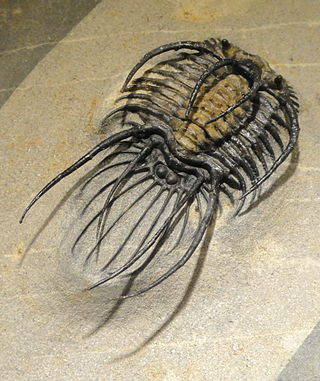| Ptychopariidae | |
|---|---|
 | |
| Ptychoparia striata from Czech Republic, at the National Museum (Prague) | |
| Scientific classification | |
| Kingdom: | |
| Phylum: | |
| Class: | |
| Order: | |
| Family: | Ptychopariidae Matthew, 1887 |
Ptychopariidae is a family of trilobites, containing the following genera: [1]
- Achlysopsis
- Altikolia
- Altitudella
- Amecephalites
- Asthenopsis
- Austinvillia
- Balangcunaspis
- Bashania
- Bathyholcus
- Bathyocos
- Billingsaspis
- Binodaspis
- Blairella – see Neoblairella [2] : 186
- Bolaspidina
- Brunswickia
- Bulkuraspis
- Caborcella
- Callidaspina
- Callidaspis
- Cathayanella
- Champlainia
- Chengshanaspis
- Chinghisicus
- Chunghwaella
- Conopolus
- Dananzhuangia
- Deltina
- Douposiella
- Elrathina
- Entsyna
- Eodouposiella
- Eokochaspis
- Eosoptychoparia
- Eospencia
- Eurostina
- Finecrestia
- Gaotanaspis
- Gaphuraspis
- Gedongaspis
- Gunnia
- Hadrocephalites
- Hadrokraspedon
- Hamptonella
- Hejinaspis
- Hemicricometopus
- Hewenia
- Holasaphus
- Horbusonia
- Illtydaspis
- Jangudaspis
- Jialaopsis
- Jianchangia
- Jimaoshania
- Jiumenia
- Kermanella
- Kochaspis
- Kochiella
- Kochiellina
- Kochina
- Kounamkites
- Kunmingaspis
- Laminurus
- Laoyingshania
- Lianglangshania
- Loriella
- Luguoia
- Luxella
- Lyriaspis
- Majiangia
- Manailina
- Meitania
- Metisella – see Rasettiella [3]
- Mexicella
- Monanocephalus
- Mopanshania
- Mrassina
- Mufushania
- Nangaocephalus
- Nangaoia
- Nangaops
- Nanoqia
- Nassovia
- Nelsonia – see Paleonelsonia [4] : 318–319
- Neoblairella [2] : 186
- Neoregina [2] : 187
- Neokochina
- Nyella – Palmerara [5]
- Olenekina
- Onchocephalites
- Ontoella
- Orienturus
- Orlovia
- Orloviella
- Pachyaspidella
- Pachyaspis
- Palmerara [5]
- Palmeraspis
- Paleonelsonia [4] : 318–319
- Panacus
- Paraeosoptychoparia
- Paragunnia
- Paramecephalus
- Paraperiomma
- Paraplagiura
- Parapoulsenia
- Parashuiyuella
- Paraziboaspis
- Perimetopus
- Periommella
- Piazella
- Pingluaspis
- Piochaspis
- Plagiura
- Pokrovskayaspis
- Poulsenella
- Poulsenia
- Poulseniella
- Probowmania
- Probowmaniella
- Probowmanops
- Proliostracus
- Promeitania
- ? Protohedinia
- Pseudoliostracus
- Psilostracus
- Ptychoparella
- Ptychoparia
- Qiaotouaspis
- Qingshuiheia
- Rasettiella [3]
- Reedus
- Regina – Neoregina [2] : 187
- Regius
- Runnania
- Salankanaspis
- Sanhuangshania
- Sanwania
- Schistometopus
- Semisphaerocephalus
- Seriaspis
- Shanganella
- Shantungaspis
- Shuiyuella
- Sinoptychoparia
- Spencella
- Spencia
- Stoecklinia
- Sujaraspis
- Suluktella
- Taijiangia
- Taniaspidella
- ? Townleyella
- Trachyostracus
- Trigonyangaspis
- Tukalandaspis
- ? Ulrichaspis
- Variopelta
- Vermontella
- Vica
- Volocephalina
- Wanhuaia
- Weijiaspis
- Wuhaina
- Xiangshanaspis
- Xingrenaspis
- Yaoyiayuella
- Yohoaspis
- Yuknessaspis
- Ziboaspidella
- Ziboaspis







